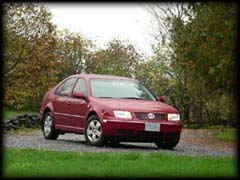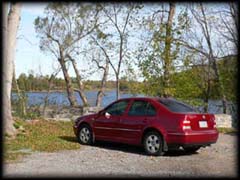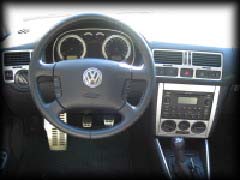

This is our first Volkswagen, and our first diesel. The 2004 model year introduced some key changes to the A4 (aka Mark IV, MkIV, Mk4) Jetta platform, most notably the 1.9L pumpe-duse ("PD"), or unit-injection, diesel motor. Other changes were cosmetic - chrome side and front grill trim, clear tail lights, and a modest lip spoiler on the trunk.
2004 Jetta TDI GLS
From the factory:
| Blue Car | |||||||||
|---|---|---|---|---|---|---|---|---|---|
| Odometer (km, at year end) |
Distance (km) |
Litres | L/100km | MPG (US) | MPG (UK) | Cost | Cost/L | Cost/100km | |
| 2008 Totals | 81,8741 | 18,159 | 876.4 | 4.83 | 48.7 | 58.5 | $1,054.56 | $1.203 | $5.80 |
| 2009 Totals | 108,467 | 26,593 | 1,400.6 | 5.27 | 44.7 | 53.6 | $1,205.41 | $0.861 | $4.53 |
| 2010 Totals | 132,832 | 24,365 | 1,233.8 | 5.06 | 46.4 | 55.8 | $1,228.78 | $0.991 | $5.01 |
| 2011 Totals | 162,180 | 29,348 | 1,652.3 | 5.63 | 41.8 | 50.2 | $2,013.47 | $1.219 | $6.86 |
| LIFETIME | 162,180 | 98,465 | 5,163.1 | 5.24 | 44.9 | 53.9 | $5,496.22 | $1.065 | $5.60 |
|
1 This car was purchased used, with 63,715km on the odometer. |
|||||||||
| Red Car | |||||||||
| Odometer (km, at year end) |
Distance (km) |
Litres | L/100km | MPG (US) | MPG (UK) | Cost | Cost/L | Cost/100km | |
| 2004 Totals | 28,8081 | 8,241 | 510.1 | 6.19 | 38.0 | 45.6 | $397.92 | $0.780 | $4.83 |
| 2005 Totals | 67,542 | 38,734 | 2,149.0 | 5.55 | 42.4 | 50.9 | $1,909.95 | $0.889 | $4.93 |
| 2006 Totals | 98,681 | 31,139 | 1,611.6 | 5.18 | 45.4 | 54.5 | $1,513.29 | $0.939 | $4.83 |
| 2007 Totals | 124,784 | 26,103 | 1,472.4 | 5.64 | 41.7 | 50.1 | $1,422.64 | $0.966 | $5.45 |
| 2008 Totals2 | 128,900 | 4,116 | 229.3 | 5.57 | 42.2 | 50.7 | $254.36 | $1.109 | $6.18 |
| LIFETIME | 128,900 | 108,333 | 5,972.3 | 5.51 | 42.7 | 51.2 | $5,489.36 | $0.919 | $5.07 |
|
1 This car was purchased used, with 20,567km on the odometer. 2 This car was involved in an accident on March 19th, 2008 and was totalled. |
|||||||||
|
|
|
 Brushed Aluminum Trim Kit
Brushed Aluminum Trim Kit
A factory available accessory kit that nicely brightens up the interior. The kit is peel-and-stick, and is well done - it fits nicely, doesn't interfere with the removal of any interior panels, and doesn't rub or creak.
The kit includes 22 individual pieces:
